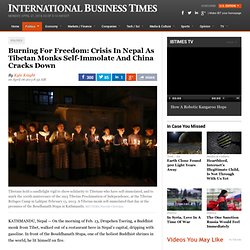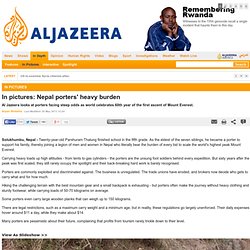

The World’s Happiest Man Is a Tibetan Monk. Burning For Freedom: Crisis In Nepal As Tibetan Monks Self-Immolate And China Cracks Down. Nepalese police put out the fire and rushed him to a hospital, but Tsering could not be saved.

He died a few hours later, with burns on more than 90 percent of his body. The 25-year old monk was one of dozens of Tibetan Buddhists who have set themselves ablaze over the past months to protest what they say is Chinese oppression of Tibet, but his case quickly became an international cause célèbre. 248843.html#.UZgQEXlxBrc. KATHMANDU, MAY 17 - The fire that raged since 10 on Thursday night razed hundreds of thousands of books at Pilgrims Book House in the heart of Thamel.

Other paraphernalia such as postcards, handicrafts and a backroom cafe that made the bookstore a resting favourite among travellers were also burned down to ashes. Photos du journal. India's monsoon seen picking up in July. India's crucial monsoon rains should pick up in July after a slow start over vast swathes of the country, which has threatened crops from rice to sugar, forecasters said.

Some 26 out of India's 36 weather zones received "deficient" or "scanty" rains in the past week from the monsoon which typically sweeps the subcontinent from June to September, according to the weather office's website on Saturday. "The monsoon rains are expected to pick up in the latter half of next week," Swati Basu, acting Director General of the India Meteorological Department (IMD), told the semi-official news agency Press Trust of India late on Friday. Basu forecast good rains in July which along with August are key months for planting and when India usually receives the maximum amount of rain. For the past week, monsoon rains were 18 percent below average while for June as a whole they have been 23 percent below average -- fanning worried murmurs about a repeat of a drought that devastated Indian farmers in 2009. Good Return - Make a difference today with microfinance.
A comment on the brawl incident 05-05-13 10AM. Sunday, 05 May 2013 04:59.

Mount Everest Fight Raises Questions About Sherpas. The weekend scuffle between a group of Sherpas and a small band of Western climbers high on Everest has raised some basic questions about the nature of the Sherpa-climber social contract, and about the culture of Sherpas.

Although the term "Sherpa" has long been a part of the popular lexicon, outsiders generally know little about the role they play in Himalayan climbing. The Sherpas are a small ethnic group that share many cultural, racial, and linguistic features with Tibetans, who live to their immediate north. About 3,000 Sherpas reside in the drainage areas immediately below Everest; a population of 20,000 or more live in villages to the south. Until the early 1950s, no high Himalayan peak in Nepal had ever been climbed—at least by mortals, the Sherpas say. Then, as now, they saw the Himalayan peaks and foothills as the realm of a cavorting pantheon of gods. Nonetheless, wives of Sherpas who climb are known to hike to Base Camp to persuade their husbands to give up expedition work.
Viewpoint: Is volunteer tourism a bad thing? Volunteering abroad to build schools or dig wells might make people feel good about themselves - but it can be detrimental to those who are supposed to be helped, writes tour company founder Daniela Papi.

I've volunteered all over the world - building homes in Papua New Guinea, doing post-tsunami work in Sri Lanka, helping paint a school in Thailand - and I used to think it was the best way to travel. In 2005 I even organised my own volunteer trip - a bike ride across Cambodia with five friends. We were going to raise funds to build a school, and teach students we met along the way about the environment and health. There turned out to be more than one small problem. We didn't really know that much about the environment or health - or Cambodia for that matter. Much of the money we had raised for other small projects had been wasted, or landed in corrupt hands.
I decided to stay in Cambodia a bit longer to see how we could better use our time and money. 248843.html#.UZgQ77vpW6o. KATHMANDU, MAY 17 - The fire that raged since 10 on Thursday night razed hundreds of thousands of books at Pilgrims Book House in the heart of Thamel.

Other paraphernalia such as postcards, handicrafts and a backroom cafe that made the bookstore a resting favourite among travellers were also burned down to ashes. The Himalayan Times (Mobile) 10 Things That Helped Me Reconnect With Kathmandu. Every city has its own wonders and pitfalls.

So does Kathmandu, Nepal's capital city. Returning to my hometown after a long stretch in the West was challenging in many ways. But over the past five months, I found ways to reconnect with Kathmandu. Here are ten of them. 1. Kathmandu is not a city of wide avenues and orderly streets. 2. If only pollution wasn't a problem and there was slightly more thought put into urban planning by previous governments, Kathmandu Valley would be a pedestrian's paradise. 3. On a clear May day, I saw a glimpse of Ganesh mountain from a friend's window and since then I have been waiting for the monsoons to pass so that I could get closer to the mountains. 4. You don't even need to leave the city to appreciate Kathmandu's natural beauty. 5.
Kathmandu Valley is located in the Warm Temperate Zone, but due to its elevation (ranging from 1,200 to 2,300 meters), the climate is truly delightful and atypical to the region. 6. 7. The other Tenzing. As the sirdar of the 1953 Everest Expedition, Dawa managed the supplies, porters, and logistics From Khumbu to London, celebrations this week to commemorate the 60th anniversary of the first ascent of Everest on 29 May 1953 focus on the two summiteers, Edmund Hillary and Tenzing Norgay, belying the fact that the climb was truly a team effort. While Tenzing was the lead climbing Sherpa, an often forgotten figure is the sirdar, the foreman of the expedition.
“Has my grandfather been completely forgotten?” Asks Tashi Sherpa of Tengboche as he sorts through a bag of old photographs. Everest: tourism and climate change provide new challenges. Unusually for someone who likes to chat, Kenton Cool can barely speak.

Exerting himself at high altitude has left his voice a throaty growl. "I cultivate it before going out in the evening," he says from Kathmandu, Nepal, having flown down from Everest base camp that morning. Cool is reflecting on a startling sequence of climbs completed over the course of last weekend. In pictures: Nepal porters' heavy burden - In Pictures. Images: /mritems/images/2013/5/26/201352615958839977_8.jpg;*;/mritems/images/2013/5/26/201352615958964881_8.jpg;*;/mritems/images/2013/5/26/201352615959261402_8.jpg;*;/mritems/images/2013/5/26/201352615959386191_8.jpg;*;/mritems/images/2013/5/26/201352615959636964_8.jpg;*;/mritems/images/2013/5/26/201352615959527757_8.jpg;*;/mritems/images/2013/5/26/201352615959886739_8.jpg;*;/mritems/images/2013/5/26/20135261510027742_8.jpg;*;/mritems/images/2013/5/26/201352615100324535_8.jpg;*;/mritems/images/2013/5/26/201352615102105867_8.jpg;*;/mritems/images/2013/5/26/201352615102464321_8.jpg;*;/mritems/images/2013/5/26/201352615102996671_8.jpg;*;/mritems/images/2013/5/26/201352615103183864_8.jpg captions: Children as young as 12 often work as porters, although the legal minimum age is 16.

They regularly carry loads of up to 70 kilograms. At times they are required to carry more as regulations are largely unenforced. Porters hit the sack after dinner at a shelter setup by Tyangboche Monastery. Fears Grow of a Himalayan Tsunami as Glaciers Melt. Melting glaciers and rising temperatures are forming a potentially destructive combination in the deep ravines of Nepal ’s Himalayan foothills, and the Phulping Bridge — on the Araniko Highway linking Kathmandu with the Chinese border — is a good place to see just how dangerous the pairing can be. A bare concrete pillar stands there, little noticed by the drivers of trucks, laden with Chinese goods, that rattle along at high speeds across the bridge, about 110 km from Kathmandu.
The pillar is all that’s left of the original Phulping Bridge, which was swept away by floodwaters in July 1981. The deluge was not caused, as is common, by monsoon rain, but by the bursting of a glacial lake. The force of the raging torrent was strong enough to dislodge boulders 30 m across. They still lie in the Bhote Koshi River. ( PHOTOS : Vanishing Glaciers ) Glacial-lake outbursts, as they’re known, are not new. Earthquakes also add to the risk. 'We owe everything to Everest and Hillary' Adam Dickson is a big, sunburned farmer from northern England who last week climbed Mount Everest on his own, descended the 8,848-metre peak, negotiating the fearsome glacial icefall, and then walked down the long trail to Namche, the village 5,500m below the summit which is effectively the gateway to the highest mountains in the world. At the same time, 19-year-old Tsering Sherpa was on his way up. A helicopter brought him most of the way from Kathmandu, 90 miles away, where he is studying accountancy.
At a bar near the landing pad, Tsering, Ray Bans pushed back on his forehead, stopped to have a drink with some Dutch and Israeli tourists. Then iPhone in hand, he continued on foot, past scores of guesthouses and cafes on the well-laid, well-maintained path to Namche, where he was born. "Carry my own bag? Out of the sheds: Women fight segregation in rural Nepal. In this tiny riverside town in Nepal’s remote Far West region, a spitfire activist explains his fight against chaupadi, the local custom of isolating women from their families during menstruation.
Skip to next paragraph Maheshwari Bista, seen here in November 2012, says that when has her period, she sleeps in this room in her house in Bhageshwar village, Achham, Nepal. Six years ago, when Maheshwari and her husband, Tanka, constructed the house, they set an example that others have followed by building a separate room for this purpose within the house, rather than making Maheshwari sleep in an outside shed. Allison Shelley Subscribe Today to the Monitor Click Here for your FREE 30 DAYS ofThe Christian Science MonitorWeekly Digital Edition For generations here, menstruating women have slept outside of their homes, in small sheds or in the family stable. Mr. In Achham, villages are nestled into steep, arid mountains. Climate change may be baring Mount Everest. A warming climate is melting the glaciers of Mount Everest, shrinking the frozen cloak of Earth’s highest peak by 13% in the last 50 years, researchers have found. Rocks and natural debris previously covered by snow are appearing now as the snow line has retreated 590 feet, according to Sudeep Thakuri, a University of Milan scientist who led the research.
The pessimistic view of Earth’s tallest peak was presented during a meeting Tuesday of the American Geophysical Union in Cancun, Mexico. Researchers said they believe the observed changes could be due to human-generated greenhouse gases altering global climate, although their research has not established a firm connection. HISTORY of Kathmandu Nepal my diary 1978 full documentary. What will the Himalaya look like in 100 years? Five-time Everest summiteer and American filmmaker David Breashears helps raise awareness about the consequences of climate change in the Himalaya Five-time Everest summiteer and American filmmaker David Breashears helps raise awareness about the consequences of climate change in the Himalaya using science, art, and adventure through his organisation, GlacierWorks.
Nepali Times caught up with him recently to talk about the latest findings on how fast the mountains are melting. Nepali Times: How did GlacierWorks start? David Breashears : When I went to Everest as part of a documentary for the PBS series Frontline in 2007, I took along a black-and-white photograph taken in 1921 by George Mallory.